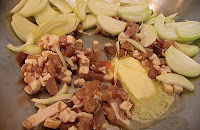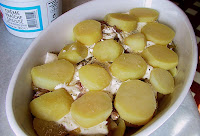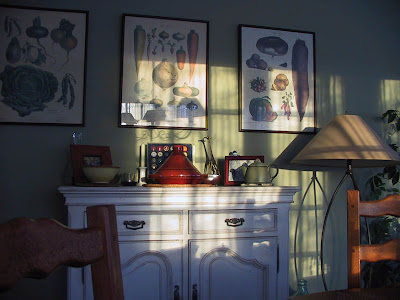For me and a lot of Southerners, field peas are a specific variety of the cowpea. Others varieties are the black-eyed pea and the crowder pea. Black-eyed peas are fairly well known across the U.S. nowadays (though they are not cooked and eaten in all regions equally), but crowder peas and field peas are mostly unknown outside the South, I'm sure. The "field peas" I know by that name are like red or dark brown black-eyed peas, with a similar but distinctly identifiable taste.
I can buy dried black-eyed peas here in France, but not crowder or field peas. The black-eyes I get in Blois or in Paris are often ones that have been imported from Portugal. The French name for them is cornilles, but I bet a majority of French people are not familiar with that term. Here's the French Wikipedia entry. It calls them Vigna unguiculata subsp. unguiculata.
"Field pea" is also a generic term that is used more or less synonymously with the name cowpea to describe the many varieties of such beans that are grown in fields, as opposed to being grown in gardens, and are often dried for long-term storage. Field peas and crowder peas are also sold canned, frozen, and even fresh in the South.
Finally, field peas are also a variety of the green garden pea, Pisum sativa. This is a different plant entirely — what we used to call "English peas" in N.C. and are called petits pois in French. These field peas are the ones grown to be dried and become what we call split peas for making purees and soups. That's a topic for another day.
The name Vigna sinensis — black-eyed peas are the best known variety — indicates that these legumes originated in China. Many sources, however, say they originally came from Africa. They were brought to the U.S. South during the slave trade in the 1700s and became a staple food in the Southern states.
Never mind, by the way, that the book titled the Dictionary of American Food and Drink (1983) says cowpeas became "a staple of the Negro diet" in the South. While that's true, it ignores the fact that Southern foods like these and collard greens and grits were dietary staples for all Southerners of all races.
As the name "cowpea" implies, all these legumes called field peas were and probably are still used as fodder for livestock. They are also very good fodder for humans. The term "black-eyed pea" goes back to at least 1738. Thomas Jefferson grew them at Monticello.
The 1997 edition of the Joy of Cooking says that black-eyed peas and their cousins the cowpeas are members of the mung bean family. Those are the beans eaten mostly as sprouts in Chinese cooking. The Joy of Cooking also says that black-eyed peas and cowpeas "have a fuller vegetable flavor than most beans." I agree with that. And you don't need to soak them before cooking because they have thin skins.
When I was in North Carolina last month, I of course spent time exploring in the supermarkets, looking for foods that I don't find here in France. I came across a bag of dried field peas. I'm more used to buying them in cans. I bought the dried ones, and then I thought about how easy it would be to bring them back to France with me. So I did and I cooked them yesterday.
I just read this in an article in the Atlanta Journal-Constitution (July 2008):
“Field peas have an affinity for smoked pig; it enhances their natural meatiness while at the same time providing a contrast to their more nuanced flavors. In my view, a pot of freshly shelled peas, slowly simmered with a piece of cured pork, is as iconically Southern as fried chicken or collard greens.”I imagine that the author is talking about the same kind of field peas that I know from N.C. I hadn't read his recommendation about "smoked pig" before I cooked my field peas, but I knew that was the perfect combination.
Smoked pork products are so good in France. I know it's not good to eat them too often or in great quantity, but it would be hard to go without them. Smoked pork belly, called lard fumé or poitrine fumée — poitrine means breast — might be called slab bacon in the U.S., but it is hard to find slab bacon back there. Here, it's everywhere. You can cut it into thin slices and cook it like bacon, or into matchstick shapes to be used as lardons, or you can just use the slab like what we call "salt pork" in the U.S. South.
And smoked sausages are amazing too. The best ones are the Montbéliard and Morteau sausages from eastern France. I've mentioned them many times in this blog. They go well with all sorts of beans — white beans, red kidney beans, black-eyed peas, and, of course, field peas.


















































